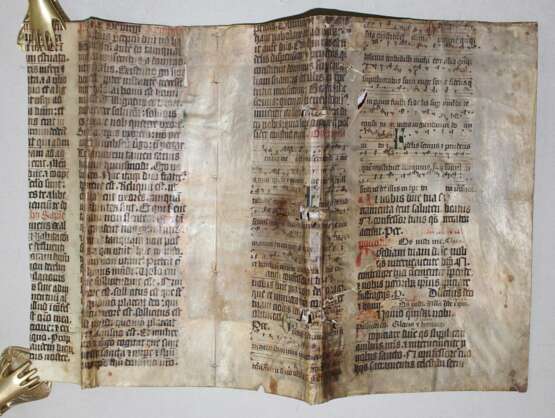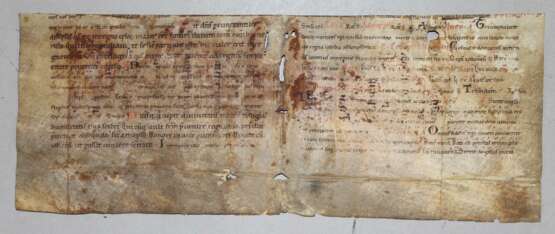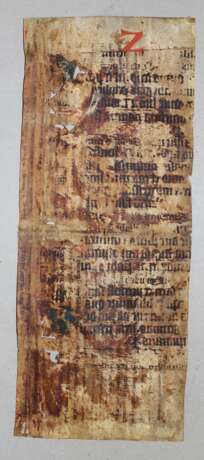Brevier.
16.12.2021 10:00UTC +01:00
Classic
Sold
800EUR € 800
| Auctioneer | Auktionshaus Kiefer |
|---|---|
| Event location | Germany, Pforzheim |
| Buyer Premium | 1. Nicht gekennzeichnte Nrn.: Aufgeld 23 zzgl. 7 Mwst; 2. Mit R gekennzeichnte Nrn.: 23 zzgl. 19 Mwst; 3. Mit D gekennzeichnte Nrn.: Aufgeld 33 inkl. MWSt% |
Archive
The auction is completed. No bids can be placed anymore.

ID 672032
Lot 153 | Brevier.
Zwei Fragmente eines Doppelblattes aus einer lateinischen Handschrift auf Pergament. Wohl Bayern, 2. Hälfte 11. Jhdt. und 12. Jhdt. (Neumen). Ca. 12 x 29,5 cm. Mit einigen kleinen Initialen und Rubriken. Schriftspiegel: ca. 12 cm breit. Einspaltig; Zeilenhöhe ca. 3-4 mm (Texte) und ca. 2-3 mm (Gesänge).
Fragmente aus einem Brevier mit Lesungen und Gesängen für die Gebetsstunden, wohl in einem Benediktinerkloster. - Die beiden etwa gleich großen Stücke stammen aus dem oberen Teil (mit dem Kopfsteg) und dem unteren Teil (mit dem Fußsteg) desselben Doppelblattes; zwischen den beiden Stücken fehlen wohl nur wenige Zentimeter. Zudem handelt es sich um das mittlere Blatt einer Lage, so daß der Zusammenhang der Lesungen und Gesänge für die Feste vom 21. September (Evangelist Matthäus) bis zum 29. September (Erzengel Michael) erkennbar ist. - Die etwas größere Textschrift für die Lesungen ist in die 2. Hälfte des 11. Jahrhunderts zu datieren. Die Neumen zu den Gesängen wurden zumindest teilweise etwas später hinzugefügt, wohl im 12. Jahrhundert. In der Ordnung der Gesänge zu den Festen des Evangelisten Matthäus, der Heiligen Mauritius, Emmeram, Cosmas und Damian, Wenzeslaus und des Erzengels Michael ist der monastische Cursus zu erkennen. Daraus ist zu schließen, daß die Handschrift wohl aus einem Benediktinerkloster stammt. Das Auftreten des heiligen Emmeram unter den Heiligenfesten spricht dabei für eine Lokalisierung in der Diözese Regensburg oder vielleicht in der Erzdiözese Salzburg, also in Bayern oder Österreich. - Die erkennbaren Texte der Lesungen entstammen dem Matthäusevangelium (Mt. 18, 1-2 und 3-10), der Homilie 22 von Beda Venerabilis, der Homilie 34 von Papst Gregor dem Großen über die Ordnungen der Engel und der Homilie 35 des Maximus von Turin. - Herausgelöst wurden die beiden hochmittelalterlichen Fragmente aus dem Inneren eines (hier beiliegenden) Pergamentumschlages, der ebenfalls aus dem Fragment eines mit Neumen notierten lateinischen Breviers bestand, wohl in Deutschland im 15. Jahrhundert geschrieben. - Auf der Rückseite des Fragmentes aus dem oberen Teil des Blattes ist die Schrift auf Grund des Abklatsches der Schrift des spätmittelalterlichen Makulaturblattes kaum noch erkennbar; auch das zweite Blatt weist stellenweise Abdrucke oder Klebereste mit Papier auf; ferner mit einigen kleinen Fehlstellen (Wurmfraßspuren), stellenweise beschabt und mit Faltspuren. - Two fragments of a double leaf from a Latin manuscript on parchment. Probably Bavaria, 2nd half of the 11th century and 12th century. With some small initials and rubrics. Scripture mirror approx. 12 cm wide. Single column; line heights ca. 3-4 mm (texts) and 2-3 mm (chants). - Fragments from a breviary with readings and chants for prayer meetings, probably in a Benedictine monastery. - On the verso of the fragment from the upper part of the leaf, the writing is barely recognisable due to a decalcification; the second leaf also has impressions or glue residues with paper in places; with some small missing parts, scuffed in places with traces of folding.
D
| Auction house category: | Old Prints, Manuscripts and Theology |
|---|
| Auction house category: | Old Prints, Manuscripts and Theology |
|---|
| Address of auction |
Auktionshaus Kiefer Steubenstraße 36 75172 Pforzheim Germany | |
|---|---|---|
| Preview |
| |
| Phone | +49 (0)7231 92320 | |
| Fax | +49-7231-923216 | |
| Buyer Premium |
1. Nicht gekennzeichnte Nrn.: Aufgeld 23% zzgl. 7% Mwst; 2. Mit R gekennzeichnte Nrn.: 23% zzgl. 19% Mwst; 3. Mit D gekennzeichnte Nrn.: Aufgeld 33% inkl. MWSt | |
| Conditions of purchase | Conditions of purchase |







